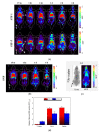Tumor Targeting Effect of Triphenylphosphonium Cations and Folic Acid Coated with Zr-89-Labeled Silica Nanoparticles
- PMID: 32630467
- PMCID: PMC7357004
- DOI: 10.3390/molecules25122922
Tumor Targeting Effect of Triphenylphosphonium Cations and Folic Acid Coated with Zr-89-Labeled Silica Nanoparticles
Abstract
In this study, we investigated the tumor targeting effect in cancer cells using triphenylphosphonium (TPP) cations, which are accumulated by differences in membrane potential, and folic acid (FA), which is selectively bound to overexpressed receptors on various cancer cells. We used Food and Drug Administration (FDA)-approved silica nanoparticles (SNPs) as drug carriers, and SNPs conjugated with TPP and FA (STFs) samples were prepared by introducing different amounts of TPP and FA onto the nanoparticle surfaces. STF-1, 2, 3, 4 and 5 are named according to the combination ratio of TPP and FA on the particle surface. To confirm the tumor targeting effect, 89Zr (t1/2 = 3.3 days) was coordinated directly to the silanol group of SNP surfaces without chelators. It was shown that the radiochemical yield was 69% and radiochemical purity was >99%. In the cellular uptake evaluation, SNPs with the most TPP (SFT-5) and FA (SFT-1) attached indicated similar uptake tendencies for mouse colon cancer cells (CT-26). However, the results of the cell internalization assay and measurement of positron emission tomography (PET) images showed that SFT-5 had more affinity for the CT-26 tumor than other samples the TPP ratio of which was lower. Consequently, we confirmed that TPP ligands affect target cancer cells more than FA, which means that cell membrane potential is significantly effective for tumor targeting.
Keywords: PET imaging; Zr-89; folic acid; silica nanoparticles; surface modification; triphenylphosphonium cation.
Conflict of interest statement
The authors declare no conflict of interest. The funders had no role in the design of the study; in the collection, analyses, or interpretation of data; in the writing of the manuscript, or in the decision to publish the results.
Figures







References
MeSH terms
Substances
Grants and funding
LinkOut - more resources
Full Text Sources
Other Literature Sources
Medical
Research Materials

